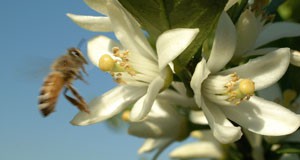Resumen
To safely solve a pest problem, growers and pesticide applicators must be aware of the potential impacts of some pest-control strategies on bees, other pollinators, and beneficial arthropods. This 14-page fact sheet written by J. D. Ellis, J. Klopchin, E. Buss, and others and published by the UF/IFAS Entomology and Nematology Department explains the issue and provides strategies to protect honey bees and other beneficial insects from pesticides.
https://edis.ifas.ufl.edu/in1027
Citas
Calderone, N. W. 2012. "Insect Pollinated Crops, Insect Pollinators and US Agriculture: Trend Analysis of Aggregate Data for the Period 1992-2009." Plos One 7:e37235. https://doi.org/10.1371/journal.pone.0037235
Delaplane, Keith, and D. F. Mayer. 2000. "Crop Pollination by Bees." Entomol Experiment Applic. 99. https://doi.org/10.1079/9780851994482.0000
Ellis, J. D., and J. Hayes. 2008. Mosquito Control and Beekeepers. ENY-149. Gainesville: University of Florida Institute of Food and Agricultural Sciences. https://edis.ifas.ufl.edu/in813
EPA. 2001. Spray and Dust Drift Label Statements for Pesticide Products. https://www.epa.gov/pesticide-registration/prn-2001-x-draft-spray-and-dust-drift-label-statements-pesticide-products
EPA. 2012. Pollinator Risk Assessment Framework Agency White Paper. http://www.regulations.gov/#!documentDetail;D=EPA-HQ-OPP-2012-0543-0004
EPA. 2020. Conditions for Minimum Risk Pesticides. https://www.epa.gov/minimum-risk-pesticides/conditions-minimum-risk-pesticides
Fishel, F. M. 2005. Interpreting Pesticide Label Wording. PI-34. Gainesville: University of Florida Institute of Food and Agricultural Sciences. http://edis.ifas.ufl.edu/pi071
Fishel, F. M., and J. A. Ferrell. 2010. Managing Pesticide Drift. PI-232. Gainesville: University of Florida Institute of Food and Agricultural Sciences. http://edis.ifas.ufl.edu/pi232
Fisher, Adrian II, Chet Coleman, Clint Hoffmann, Brad Fritz, and Juliana Rangel. 2017. "The Synergistic Effects of Almond Protection Fungicides on Honey Bee (Hymenoptera: Apidae) Forager Survival" Journal of Economic Entomology 110 (3): 802-808. https://doi.org/10.1093/jee/tox031
Fisher, A. II, and J. Rangel. 2018. "Exposure to Pesticides during Development Negatively Affects Honey Bee (Apis mellifera) Drone Sperm Viability." PLoS ONE 13 (12): e0208630. https://doi.org/10.1371/journal.pone.0208630
Gradish et al. 2019. "Comparison of Pesticide Exposure in Honey Bees (Hymenoptera: Apidae) and Bumble Bees (Hymenoptera: Apidae): Implications for Risk Assessments." Environmental Entomology. 48 (1): 12-21. https://doi.org/10.1093/ee/nvy168
Hooven, L., R. Sagili, and E. Johansen. 2013. How to Reduce Bee Poisoning from Pesticides. PNW 591. Pacific Northwest Extension Publication. Oregon State University, University of Idaho, Washington State University, 35 pp.
Johnson, R. M., M. D. Ellis, C. A. Mullin, and M. Frazier. 2010. "Pesticides and Honey Bee Toxicity-USA." Apidologie 41:312-331. https://doi.org/10.1079/9780851994482.0000
Mortensen, A. N., D. R. Schmehl, and J. Ellis. 2013. European honey bee Apis mellifera Linnaeus, and subspecies (Insecta: Hymenoptera: Apidae). EENY568. Gainesville: University of Florida Institute of Food and Agricultural Sciences. https://edis.ifas.ufl.edu/in1005
Mullin, C. A., M. Frazier, J. L. Frazier, S. Ashcraft, R. Simonds, D. vanEngelsdorp, and J. S. Pettis. 2010. "High Levels of Miticides and Agrochemicals in North American Apiaries: Implications for Honey Bee Health." PLoS One 5:e9754. https://doi.org/10.1371/journal.pone.0009754
Ostiguy, N., Drummond, F. A., Aronstein, K., Eitzer, B., Ellis, J. D., Spivak, M., and Shepherd, W. S. 2019. "Honey Bee Exposure to Pesticides: A Four-Year Nationwide Study." Insects 10 (1): 13. https://doi.org/10.3390/insects10010013
Sanchez-Bayo, F, and K. Goka. 2014. "Pesticide Residues and Bees-A Risk Assessment." PLoS ONE 9 (4): e94482. https://doi.org/10.1371/journal.pone.0094482
Thompson, H. M. 2001. "Assessing the Exposure and Toxicity of Pesticides to Bumblebees (Bombus sp.)." Apidologie 32:305-321. https://doi.org/10.1051/apido:2001131
Winston, M. L. 1987. The Biology of the Honey Bee. Harvard University Press, Cambridge, Massachusetts, USA. 281 pp.
Wu, J. Y., C. M. Anelli, and W. S. Sheppard. 2011. "Sub-Lethal Effects of Pesticide Residues in Brood Comb on Worker Honey Bee (Apis mellifera) Development and Longevity." PLoS ONE 6 (2): e14720. https://doi.org/10.1371/journal.pone.0014720
Unless otherwise specified, articles published in the EDIS journal after January 1, 2024 are licensed under a Creative Commons Attribution-NonCommercial-NoDerivs 4.0 International (CC BY-NC-ND 4.0) license.

